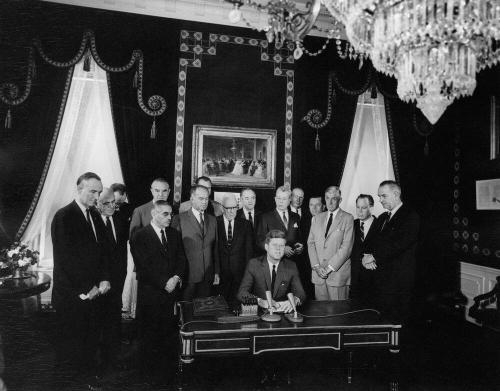President Barack Obama’s announcement of a new system for protecting America’s allies against Iranian missiles has ignited charges that he is scaling back the one he inherited from George W. Bush as a concession to the Russians.
In fact, the Obama plan is a big improvement on the Bush one, and it is designed to counter an evolving Iranian threat, not to mollify Russian anxieties.
Mr Bush’s decision to put 10 missile interceptors in Poland and an associated radar in the Czech Republic was based on a concern that Iran was developing long-range rockets that could hit the US. The Bush system would have been less effective against shorter-range Iranian missiles, and it would have left much of Europe, notably including US ally Turkey, unprotected.
Over the last several years, the Iranians have shifted their efforts from developing a few long-range rockets to deploying large numbers of shorter-range ones that pose an immediate danger to south-eastern Europe and the Middle East, as well as to US forces stationed there. Unlike Mr Bush’s, Mr Obama’s plan will quickly field a missile-defence capability to address an existing threat. It can be upgraded to deal with longer-range Iranian missiles in the future.
The central Europeans who have reacted to the decision with apprehension or alarm should recognise that the replacement of a conceptually flawed plan with a more credible one strengthens the bonds of transatlantic defence.
The view from Moscow has been clouded by outright paranoia. Military experts there suspected that the US rockets in Poland, while advertised as defensive, could be used offensively, even pre-emptively, against Russia. Laying to rest that far-fetched scenario was not the prime motivation for Mr Obama’s decision, nor should it have been. However, by removing what has been a gratuitous irritant in bilateral relations, the president has improved the prospects for US-Russian arms control negotiations now under way in Geneva.
Those talks could produce by December a new treaty reducing numbers of strategic – that is, intercontinental – weapons. If ratified by the US Senate (which will not be easy, given the ferocity of the partisan wars in Washington), the US and Russia will be on track for further reductions in the future. Mr Obama and Dmitry Medvedev, the Russian president, who are due to meet in New York this week, have jointly called for the eventual goal of eliminating nuclear weapons.
As they and their successors take steps in that direction, they will have to grapple with a stark paradox of the nuclear age: mutual deterrence depends on each side being vulnerable to retaliation from the other. If either side has enough defences to trump the other side’s offence, the mutuality of deterrence breaks down and one or both sides will be on hair-trigger, making war more likely in a crisis.
American statesmen pounded this inescapable truth into the heads of their initially sceptical Soviet counterparts 40 years ago. The result was the anti-ballistic missile (ABM) treaty signed by Richard Nixon and Leonid Brezhnev in 1972. By limiting the defensive capability of both superpowers, the ABM treaty was a necessary companion piece to a series of treaties setting ceilings on offensive weaponry. Because nuclear weapons were expected to be with us forever, the ABM treaty was meant to last in perpetuity.
While the Soviets were converted to the logic of restricting defence, Ronald Reagan was not. The late US president championed the development of a space-based comprehensive shield that would make offensive weapons – and therefore mutual deterrence – “impotent and obsolete.”
Many experts believed Reagan’s vision, derisively nicknamed “Star Wars”, was an impossible dream. So did his successor, George H. W. Bush, who treated the programme with benign neglect while negotiating with the Russians in the strategic arms reduction talks (Start) begun by Reagan.
The second President Bush reversed his father’s policy. He greatly weakened the Start process, pulled the US out of the ABM treaty and sought to revive a national missile defence (NMD) system. His decision to build the interceptor and radar sites in Poland and the Czech Republic was, as one of his aides told me at the time, in large measure about “pouring concrete for what will eventually be a global NMD”.
Key officials of the Obama administration – including the president himself, who studied arms control in college – understand the linkage between reduction of offences and regulation of defences. However, they have avoided raising that issue in the context of last week’s decision. That is partly because they want their plan to be judged on its own merits, vis-à-vis the Iranian threat. But it is also because they have more than enough fights with the Republicans without further energising the right wing by trying to reinstate the principles of the ABM treaty.
Yet sooner or later the US administration will have to grasp the nettle of regulating strategic defences. Otherwise, continued reductions in strategic nuclear offences will be either impossible or, worse, dangerous.



Commentary
Op-edA Better Base for Cutting Nuclear Weapons
September 20, 2009